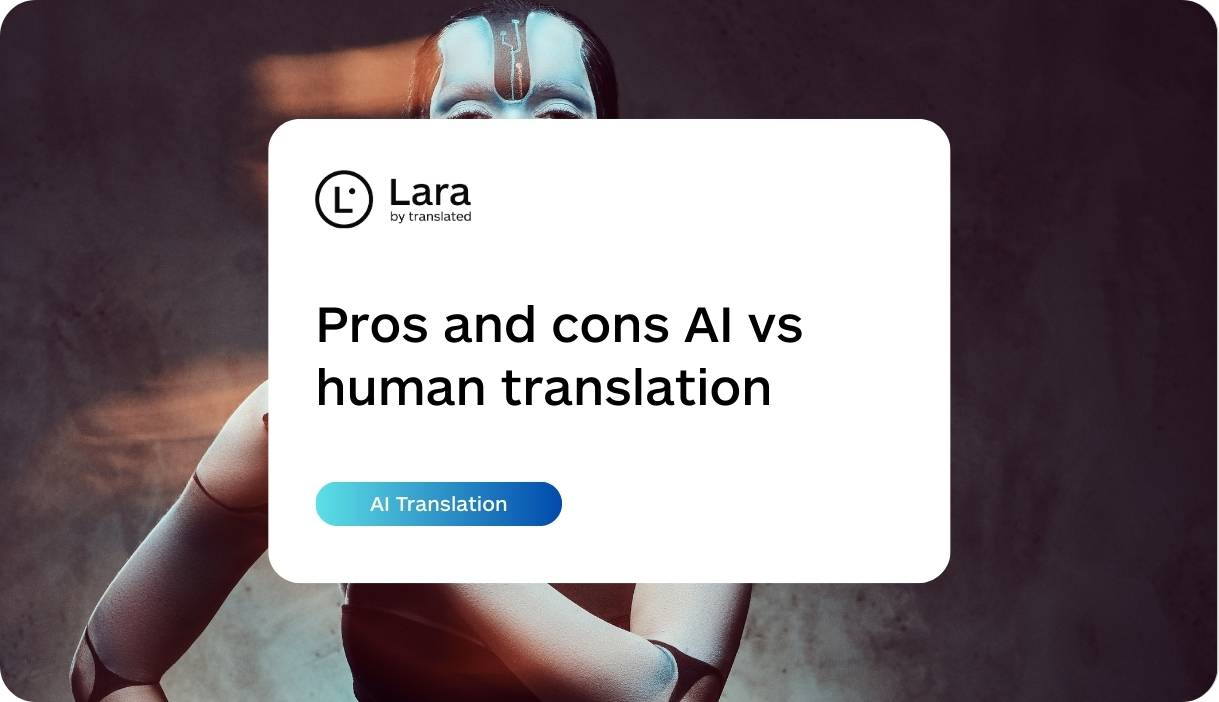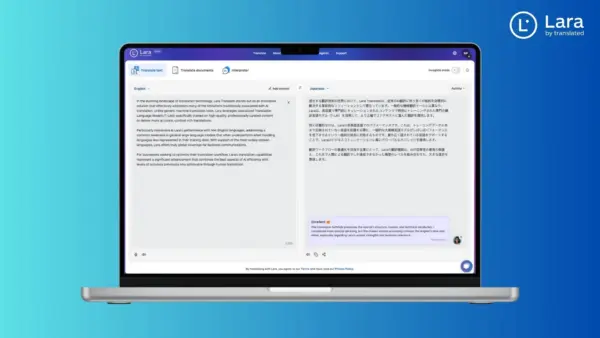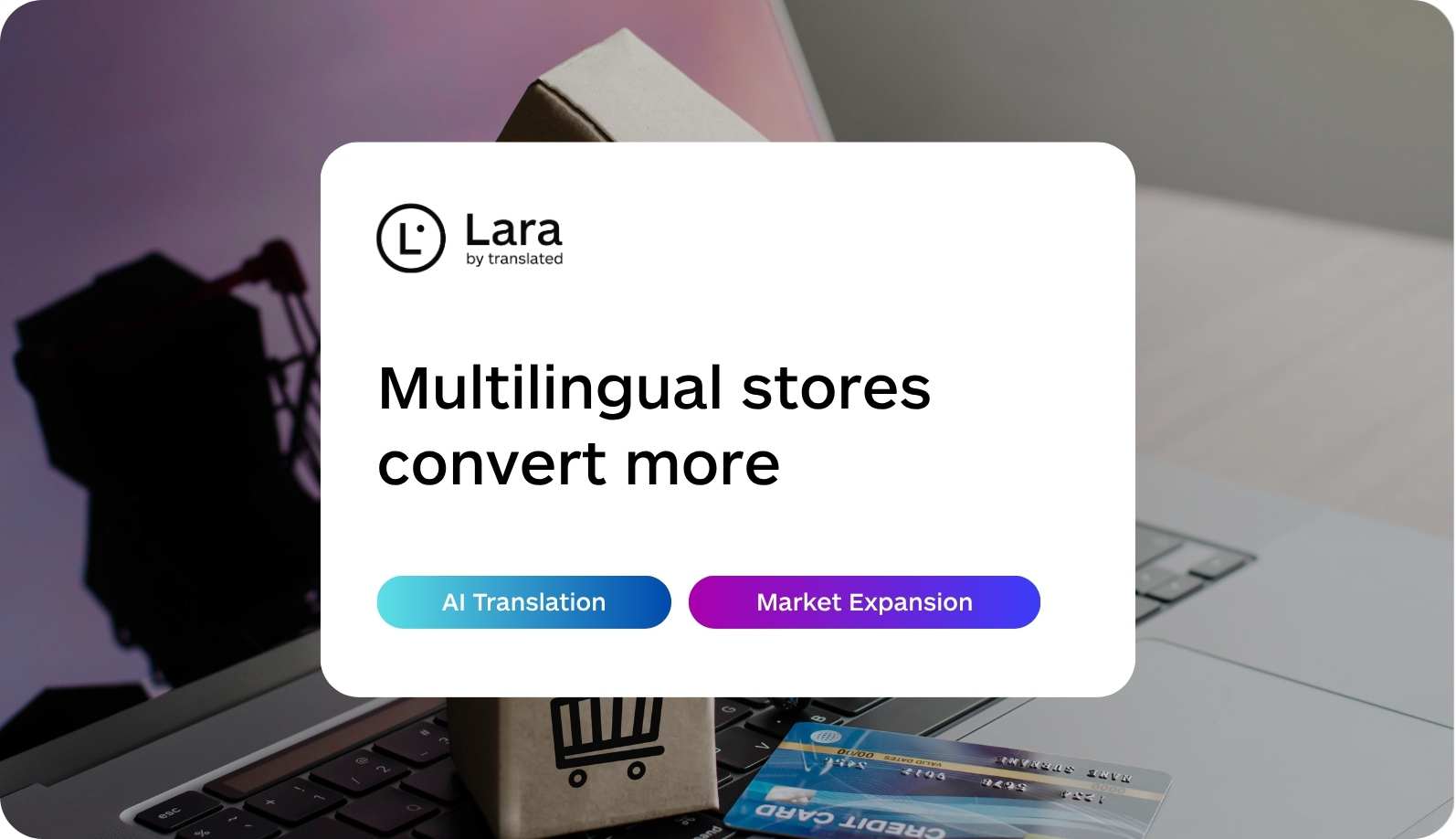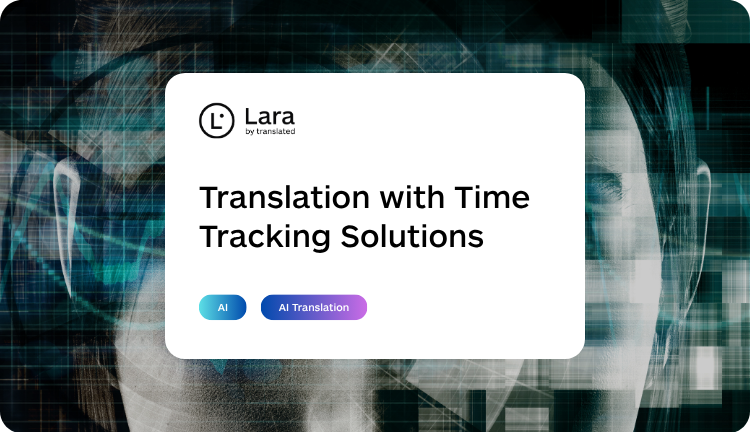When you’re taking your business global, one big question always comes up: should you use AI to handle your translations, hire human translators, or mix both? It’s not a small decision; it affects your budget, your deadlines, and most importantly, whether your message actually lands with people in other countries.
Language barriers can still trip up even the best global strategies. That’s why it really helps to understand what AI is great at, where human translators make all the difference, and how to balance the two to get the best results.
The current state of translation technology: AI vs human expertise
Today’s translation landscape represents a fascinating intersection of cutting-edge artificial intelligence and skilled human expertise. The comparison of AI and human translators reveals fundamental differences in how each approach processes language and conveys meaning across cultural boundaries.
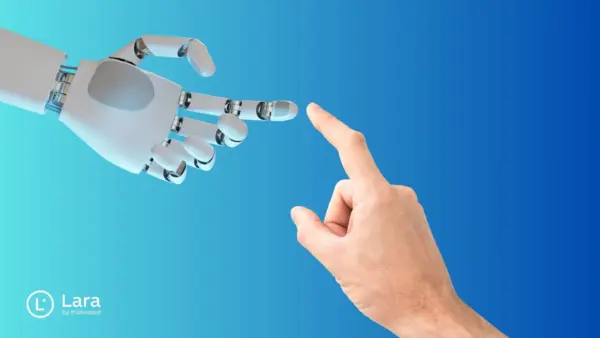
Modern AI translation systems have evolved dramatically from earlier statistical models to sophisticated neural networks that can process context and deliver remarkably fluent results in many language pairs. These systems continuously learn from vast datasets, improving their accuracy and contextual understanding with each iteration.
Human translators, meanwhile, bring a wealth of cultural knowledge, subject matter expertise, and nuanced understanding of language that remains unmatched. Their ability to interpret tone, emotion, and cultural subtext ensures messages retain their intended impact across language barriers.
For businesses navigating this landscape, the choice isn’t always binary. Many are discovering that the optimal solution often involves leveraging the strengths of both approaches based on content type, audience needs, and business objectives.
Benefits of human translation over AI
Professional translators excel at maintaining the nuances that make communication effective. Their cultural insights allow them to adapt content in ways that resonate authentically with local audiences, preserving not just words but cultural context, humor, and emotional impact. This language nuance preservation is particularly critical for marketing materials, creative content, and sensitive communications where subtle meanings can significantly impact audience reception.
Human translators also bring specialized expertise to technical fields. Whether translating legal contracts, medical documentation, or engineering specifications, subject-matter experts understand the terminology and conventions specific to these domains. This specialized knowledge ensures accuracy in fields where mistranslations could have serious consequences.
Perhaps most importantly, human translators can exercise judgment and creativity when needed. They can recognize when literal translation would be inappropriate and adapt content accordingly, maintaining the spirit of the original while making it culturally appropriate for the target audience.
Consider this example: A marketing slogan using wordplay or cultural references would likely confuse foreign audiences if translated literally. A skilled human translator would adapt the content to create an equivalent impact in the target language, preserving the message’s intent rather than just its words.
Advantages and disadvantages of AI translation
AI translation technology has made remarkable strides in recent years, offering compelling benefits while still facing notable limitations. Understanding these strengths and weaknesses is essential for determining when AI translation is appropriate for your business needs.
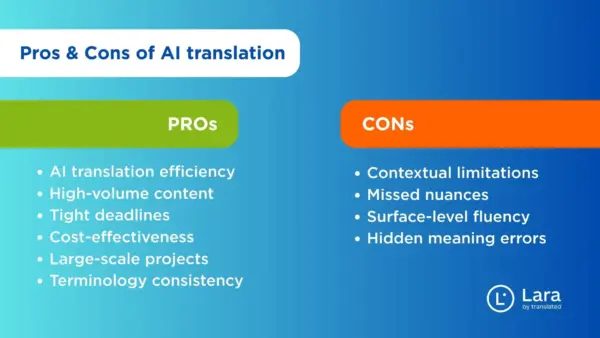
Key advantages:
AI translation efficiency is perhaps its most compelling benefit. Modern systems can process thousands of words in seconds, making them ideal for high-volume content with tight deadlines. This speed enables businesses to translate vast amounts of content that would be impractical to handle through human translation alone.
Cost-effectiveness is another significant advantage. AI translation generally costs a fraction of human translation services, particularly for large-scale projects. This makes global communication more accessible for businesses with limited localization budgets or those needing to translate substantial volumes of content regularly.
Consistency is also a notable strength. Once properly trained, AI systems apply terminology and style guidelines uniformly across all content, eliminating the inconsistencies that can occur when multiple human translators work on the same project.
Key disadvantages:
Despite these benefits, the question “is AI translation reliable?” remains valid due to several persistent concerns. According to most, the technology still struggles with contextual understanding in translation, often missing subtle meanings, cultural references, or idioms that human translators would readily grasp.
AI systems can produce translations that appear fluent on the surface but contain fundamental errors in meaning or tone. This is not particularly problematic for languages with simple grammar systems as the English.
Lara Translate: bridging the gap between AI and human translation
In the evolving landscape of translation technology, Lara Translate stands out as an innovative solution that effectively addresses many of the limitations traditionally associated with AI translation. Unlike generic machine translation tools, Lara leverages specialized Translation Language Models (T-LMs) specifically trained on high-quality, professionally curated content to deliver more accurate, context-rich translations.
Particularly impressive is Lara’s performance with non-English languages, addressing a common weakness in general large language models that often underperform when handling languages less represented in their training data. With support of the most widely spoken languages, Lara offers truly global coverage for business communications.
For businesses seeking to optimize their translation workflow, Lara’s translation capabilities represent a significant advancement that combines the best aspects of AI efficiency with levels of accuracy previously only achievable through human translation.
When to use human translation vs AI translation
Making the right choice between human and AI translation depends on understanding which approach best suits specific content types and business objectives. This decision framework can help guide your strategy:
Human translation is typically best for:
- High-stakes content where accuracy is paramount, such as legal contracts, patents, or medical documentation
- Creative and marketing materials that require cultural adaptation and emotional resonance
- Content with complex cultural references, idioms, or wordplay that machines struggle to interpret
- Brand-defining content like taglines, mission statements, or core messaging
- Highly technical or specialized texts in fields like medicine, law, or engineering
AI translation works well for:
- High-volume, time-sensitive content like product descriptions, support articles, or user-generated content
- Internal communications and documentation where perfect phrasing is less critical
- Content with short lifecycles like news updates or time-limited promotions
- Standardized, repetitive documents with established terminology and predictable structures
- Early-stage drafts that will undergo human review before publication
Many organizations are now adopting a hybrid approach that combines AI and human translation based on content type and purpose. For example, using AI for the initial translation of large volumes of content, followed by human review and refinement for client-facing materials. This approach optimizes both speed vs accuracy and cost-efficiency.
Cost differences between AI and human translators
Understanding the financial implications is crucial when deciding between AI and human translation. The cost-effectiveness of translation varies significantly between these approaches:
Human translation typically costs between $0.08 and $0.30 per word, depending on language pair, content complexity, and translator expertise. Specialized fields like legal or medical translation command premium rates, often exceeding $0.25 per word. For a standard 10,000-word document, professional human translation might cost between $800 and $3,000.
AI translation solutions generally follow subscription-based or pay-as-you-go pricing models. Many platforms charge monthly fees based on volume, with costs typically ranging from $0.001 to $0.015 per word. This represents a fraction of human translation costs, particularly for high-volume projects.

However, these direct costs don’t tell the complete story. When evaluating the true cost difference, consider these additional factors:
- Post-editing requirements: AI translations often require human review and editing to ensure quality, adding costs that should be factored into the total investment.
- Error costs: Mistakes in translation can carry significant business costs, from reputational damage to legal liability. For critical content, the lower upfront cost of AI may be offset by higher risk.
- Time savings: AI’s speed delivers value beyond direct cost savings, allowing faster market entry and more responsive communication.
- Volume considerations: The cost advantage of AI becomes more pronounced with higher volumes, making it particularly attractive for large-scale translation needs.
For many businesses, a mixed approach optimizes both quality and cost-efficiency. Using AI for initial document translation with human review for critical content often delivers the best value, especially for ongoing translation needs.
Case study: AI vs human translation in action
To illustrate the practical implications of choosing between AI and human translation, let’s examine a real-world scenario of a mid-sized software company expanding into multiple European markets.
The challenge
The company needed to translate its website, product documentation, marketing materials, and legal agreements into five European languages. With over 150,000 words of content and plans for regular updates, they faced significant translation requirements on an ongoing basis.
The approach
After careful consideration, the company implemented a hybrid strategy:
- Marketing materials and brand messaging: These were entrusted to professional human translators with marketing expertise in each target market, ensuring culturally appropriate messaging that resonated with local audiences.
- Product documentation and support articles: The company used Lara Translate to handle the bulk translation of technical documentation, followed by review from in-country product specialists who focused on terminology accuracy rather than rewriting entire documents.
- Legal documents: These were translated by specialized legal translators to ensure complete accuracy and compliance with local regulations.
- User interface text: The development team used AI translation with human review for UI elements, maintaining glossaries to ensure terminology consistency.
The results
This strategic approach delivered several key benefits:
- Cost optimization: By reserving human translation for high-impact content, the company reduced overall translation costs by approximately 65% compared to an all-human approach.
- Accelerated timeline: The company launched in all five markets three months earlier than would have been possible using only human translation resources.
- Quality assurance: By applying appropriate quality control measures based on content criticality, they maintained high standards where it mattered most.
- Scalability: The approach easily accommodated regular content updates and additions, allowing the company to maintain synchronized experiences across all language versions.
This case demonstrates how a nuanced understanding of when to use human translation versus AI can optimize both quality and efficiency. Rather than treating translation as a binary choice, successful global businesses increasingly adopt content-specific strategies that leverage the strengths of both approaches.
Who wins in translation: human or AI?
The question of who wins in translation: human or AI frames the issue as a competition, but the reality is more nuanced. Rather than declaring an absolute winner, businesses benefit most from understanding that these approaches serve different needs and can complement each other effectively.
AI translation has made remarkable progress, particularly in terms of speed, accessibility, and handling high volumes of content. For certain use cases—like translating user-generated content, internal communications, or providing real-time language support—AI offers clear advantages that human translation cannot match.
Yet, for materials that require deep cultural sensitivity, emotional nuance, or a finely tuned brand voice, human translators continue to offer valuable expertise—especially where persuasive impact or technical precision is critical.
The most successful global businesses recognize that the real winner is the strategic combination of both approaches. By leveraging AI for its efficiency and scale while applying human expertise where it adds the most value, companies can optimize both quality and cost-effectiveness in their global communications.
AI systems, as Lara Translate, will handle increasingly complex linguistic tasks, while human translators will focus more on cultural consultation, content strategy, and quality assurance—creating global communications that are both efficient and effective.
The ultimate winner isn’t human or AI translation, but the businesses that skillfully leverage both to connect with global audiences authentically and efficiently.
FAQ: Common questions about AI vs human translation
How accurate is AI translation compared to human translation?
AI translation accuracy varies by language pair and content type, typically ranging from 85-95% for common language pairs. Human translation generally achieves 98-99% accuracy when performed by professional translators. For technical or specialized content, the accuracy gap widens significantly in favor of human translation.
Can AI translation replace human translators completely?
For most business applications, AI cannot completely replace human translators, particularly for content requiring cultural adaptation, creative expression, or specialized knowledge. However, AI can handle routine, high-volume translation tasks effectively, changing the role of human translators to focus more on review, cultural adaptation, and high-value content.
How do I know if my content needs human translation?
Consider human translation for content that is brand-critical, legally binding, culturally nuanced, creative in nature, or highly technical. Content with a long lifecycle, high visibility, or significant business impact generally benefits from human translation or at minimum, human review of AI-translated content.
What industries benefit most from human translation?
Legal, medical, marketing, literary, and technical fields typically benefit most from human translation due to their specialized terminology, potential liability issues, and need for cultural adaptation. Industries with strict regulatory requirements also tend to favor human translation for compliance-related content.
How can I improve the quality of AI translations?
To enhance AI translation quality, provide clear source content, maintain terminology glossaries, use style guides, and implement post-editing processes for critical content. Training custom AI models with your company’s specific terminology and previous translations can also significantly improve results.
This article is about:
- The strengths and limitations of AI vs human translators across different business use cases
- When to choose human translation for content requiring nuance, accuracy, or cultural sensitivity
- Budgeting considerations and cost comparisons between AI-driven and human translation services
- A real-world case study and final insights into who performs best in today’s global translation landscape
